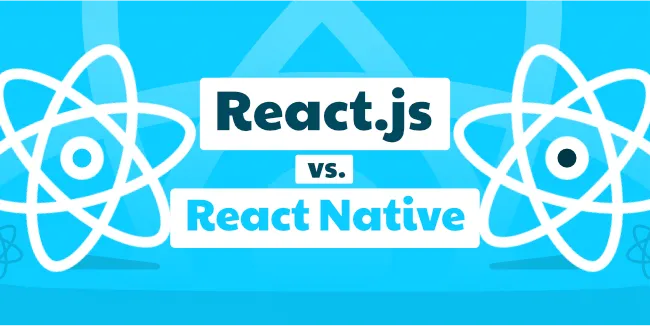ReactJS and React Native are powerful tools that are used by developers around the world to build the highest quality mobile and web applications. Despite their many similarities, there are key differences between ReactJS and React Native that developers should be aware of before deciding which tool to use for their next project.
This is exactly what we will deal with in this article, and we will try to show each technology’s advantages and disadvantages clearly, how they differ from each other, which technology you should choose when creating a mobile app and which when creating a web app. But let’s start from the beginning.
React JS – Frontend Library

React is a declarative, efficient, and flexible JavaScript library for building user interfaces. It lets you compose complex UIs from small and isolated pieces of code called “components”. React JS works in a similar way to React Native. Considering the popular software design pattern – Model View Controller (MVC), it’s logical that React JS is in charge of “View,” which includes everything the consumer sees in the application. Jordan Walke developed React JS, the initial prototype of which was called “FaxJS,” while working at Facebook in 2011. It became public at the JS conference in 2013.
This JavaScript library uses code designed for the web (HTML) in its architecture, so while it may be utilized to create a mobile app, the natural use of React JS is in web development. Web applications created with React JS have attractive and transparent user interfaces, therefore, most of the apps developed with its use are dynamic Single Page Applications (SPA). When needed, the SPA updates information using JavaScript APIs.
The ReactJS code is converted into HTML pages on the web server. The main advantage of using server-side rendering is that it improves the performance of your website as the initial loading time is faster. Static websites are easy to develop, deploy, and maintain.
Companies that took advantage of ReactJS
React JS is one of the most powerful front-end libraries on the market. That’s why it has been used by one of the biggest players in the world for building its web applications. Here are some of the companies that use React JS:
The giant social media company uses React for its web applications. The company has developed a number of applications using React, including the Facebook ad manager application and the create-react-app CLI tool.
Netflix
One of the most popular video streaming services uses React for its web UI. Netflix reported that they have started using React because it runs faster than their previous JavaScript framework and is more scalable.
The photo and video-sharing social media platform developed the web version of its app using React.
Dropbox
This file-hosting service uses React to power its content previews on the web.
As you can see, some of the world’s most popular companies use React for their web applications. If you are looking to build a large-scale web application, React could be a choice for you.
Advantages and disadvantages of ReactJS
ReactJS, as well as everything in this world, has its advantages and disadvantages. This part of the article will take a closer look at its pros and cons.
Advantages of ReactJS

Virtual DOM (Document Object Model)
React’s speed and efficiency are thanks to the Virtual DOM (Document Object Model). It allows developers to design quick applications that meet modern requirements. VDOM is a virtual re-creation of the document object model, or in other words, a virtual replica of the tree structure of XML, HTML, or XHTML documents.
The conventional DOM is based on a tree architecture, so if anything beneath it changes, the application may be negatively impacted. React JS’s Virtual DOM, on the other hand, allows virtual modifications to the DOM. It implies that before the user sees any changes, the algorithm analyzes where these should be made and how they can be done best.
Components
ReactJS was created with developers in mind, and maybe that’s why it comes with reusable components out of the box. Components are the building blocks of a React application, so it’s only natural that they should be easy to construct and use.
Basically, a component is like a small, self-contained piece of code that performs a specific task. When you create new React UI components, you can think of them as a small template that you can reuse over and over again. This modular approach can make your code more organized and easier to understand.
And since components are so important in ReactJS, the framework makes it simple to break down complex UI into smaller, more manageable pieces. In fact, you can think of ReactJS as one big component made up of smaller ones.
SEO
SEO stands for Search Engine Optimization, and it is a very important factor that influences whether your app will be visible in the Google search engine. If you want your app to be visible on Google, then you need to make sure that your app is properly optimized.
And one of the best ways to optimize your app is to use ReactJS. ReactJS is a very SEO-friendly framework, and it can help you boost your app’s visibility in the search engine. In fact, many developers believe that ReactJS is the best framework for SEO.
As a result, React is used in the most demanding applications because it improves the performance of a web app’s loading time and rendering speed. That alone adds up to a lot of extra performance for a website. In fact, Google appears to do an excellent job indexing React-based apps.
Disadvantages of ReactJS

Documentation
The documentation for React is very good, but it is also constantly changing. As a result, it can be difficult to keep up with the changes. In addition, the documentation does not always provide clear examples. While this can be a problem for beginners, experienced developers should have no trouble understanding the documentation.
Complexity
React is a very complex framework. It can be difficult to understand how React works, and it can take a long time to get started with React. As a result, React is not a good choice for beginners.
Additionally, as we mentioned React, it is constantly evolving, which means that even if you learn its complicated mechanics, there may come a day when they change and you will have to learn them from scratch.
React Native – UI framework

React Native was built on the basis of ReactJS, and it can be described as an open-source Javascript-based framework. Its main focus is cross-platform apps development. This means that with React Native, you can create an application for both iOS and Android, and it will be based on one codebase. Mobile apps built with React Native are very similar to those built natively in terms of performance and appearance. The main difference is that React Native uses JavaScript and not the traditional Objective-C or Java.
React Native comes with a number of built-in components which you can use while building your app. These components help you create a basic layout for your app. You can also create your own custom components and use them in your app. React Native also has a large community of developers who are always creating new and innovative ways to use the framework.
React Native is the first cross-platform mobile app development framework that is built on top of web technologies like HTML and Javascript. It makes your React Native project more stable and efficient. It also operates on two independent threads.
The first thread, which is also seen in native applications, creates the user interface and responds to gestures; the second thread, on the other hand, executes JavaScript code on a different JavaScript engine. The JS thread is in charge of the entire structure and features of the user interface. These two components can communicate seamlessly thanks to the “bridge.” React Native can become the basis of your success if you find a trusted mobile development company.
Companies that took advantage of ReactJS
As you can see, React Native is truly a masterpiece of a framework. Lately, a lot of companies decided to create their mobile applications with the use of this Facebook solution. Here are a couple of such companies.
Airbnb
The world’s most popular accommodation booking application is based on React Native. The founders decided to go this way in order to have better control over platform updates, reduce development time and release features faster.
The React Native framework was created by Facebook, so it is only logical that the social media giant would use it for its own purposes. The app has been improved a lot since its early days, and now it provides an excellent user experience.
Instagram is another Facebook property that uses React Native. The app makes use of the platform’s UI components and modules, which helps it deliver a smooth user experience.
Skype
Skype decided to use React Native in order to improve its performance on low-end devices. The application was rewritten from the ground up, and it now provides a much better user experience.
Advantages and disadvantages of React Native
As with ReactJS, React Native has its own strengths and weaknesses. Let’s take a closer look at them.
Advantages of React Native

Cross-platform development
React Native allows you to create platform-specific code for both iOS and Android with a single codebase. This can save you a lot of time and effort, as you don’t have to develop and maintain separate codebases for each platform. React Native code can be reused in as much as 90% between iOS, and Android platforms, which makes it a great choice if time-to-market is important for you.
Hot-reloading feature
The hot-reloading feature is one of React Native’s greatest advantages. With this feature, you can see the changes you made to your code immediately on your device or simulator without having to recompile the whole app each time. This way, you can save a lot of time, as the updated code shows in real-time on your screen.
Components
React Native similar to ReactJS, allows developers to use components, which are reusable parts of code. Thanks to React Native components, developers can make the development process more efficient and organized, as building a mobile app with components is like building with lego bricks.
Additionally, this great framework allows for the use of the native UI components. Native app components enable developers to make the UX/UI of the final app just stunning! The fact that you should also know is that React Native compiles native app components, allowing you to create native mobile applications.
Disadvantages of React Native

Not all native features are available yet
React Native still has some limitations, as not all the components of each operating system are available yet. In other words, there might be situations where you will have to create a native component from scratch to achieve your desired outcome. However, creating a couple of components from scratch is still better than building a whole app from scratch!
Requires knowledge of both platforms
Even though a big part of the native React code can be reused, you will still need to have basic knowledge of both iOS and Android platforms in order to be able to create React Native native apps. You will also need to be familiar with JavaScript and ReactJS in order to be able to work with React Native effectively.
There is a learning curve
Even though you might be able to reuse some of your native code, there is still a learning curve associated with React Native. You will need to learn about the different ways to style components and work with the platform-specific APIs. In addition, you might need to debug issues that are specific to React Native.
ReactJS vs React Native

We have already learned about both solutions with “React” in the name. As you may have noticed, they differ quite significantly from each other, despite the fact that they are basically based on similar mechanics. So, what is the main difference?
ReactJS is a JavaScript library for building user interfaces. It was originally created by Jordan Walke, a software engineer at Facebook. React Native, on the other hand, is a mobile framework that is designed to create cross-platform mobile apps for platforms like Android and iOS.
While ReactJS can be used to create apps, and web pages that run in web browsers, React Native can be used to create apps that run on mobile devices. This is the main difference between these two popular technologies.
ReactJS also uses a virtual DOM, while React Native uses native components instead. This means that when you create a React Native app, you are essentially creating a native app that will work on both Android and iOS devices.
Additionally, ReactJS has a smaller learning curve than React Native. This is because it is a JavaScript library, and as such, it is easier to learn for developers who are already familiar with JavaScript. React Native, on the other hand, requires knowledge of Java or Objective-C for Android development and Swift or Objective-C for iOS development.
While ReactJS is a great option for creating user interfaces for web pages and apps, React Native is the better choice for creating cross-platform mobile apps. This is because React Native uses native components, which results in better performance than ReactJS. In addition, ReactJS does not have the ability to access some of the native features of devices, such as the camera or GPS.
Conclusion
If you’re looking to create a cross-platform mobile app, then React Native is the way to go. However, if you’re just looking to create a user interface for a web page or app, then ReactJS would be a better option.
If your solution should consist of web and mobile apps, creating them in ReactJS and React Native is a great way to go, as they should offer a similar user experience!



